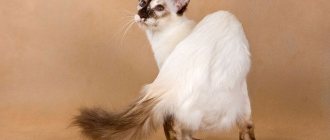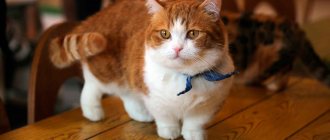Can a human shadow have a tail and four legs? Maybe if there is a Balinese cat in the house, which always follows on its owner’s heels. This graceful cat with expressive almond-shaped eyes moves as gracefully as a Balinese dancer. She loves to be the center of attention and does not tolerate loneliness well.
Balinese cat: description of the breed
Key facts
The official name of the breed is Balinese, or Balinese cat, and its abbreviated name is Balinese. The country of origin of these animals is recognized as the USA, where breeders first began breeding Siamese with long hair. Thanks to this close relationship, the description of Balinese cats largely coincides with Siamese cats.
On average, these animals live about 13 years. With good care, the maximum life expectancy of Balinese cats reaches 20 years.
Despite their regal appearance, Balinese are quite playful, curious, talkative and loyal. Also, the key characteristics of the Balinese cat breed include high intelligence. The pet quickly remembers the habits of its owners and skillfully manipulates their reactions, using different intonations to satisfy its desires.
Nurseries
There are few nurseries in the country that breed Balinese dogs. Before choosing the right one, they collect information and read reviews. A trustworthy nursery is considered to be one in which suitable conditions have been created for Balinese kittens, the animals are litter trained, and participate in exhibitions.
The price of a Balinese pet-class cat is from 15 thousand rubles. If a pet is purchased to participate in exhibitions, the cost starts from 30 thousand rubles. The high cost of Balinese dogs is explained by the costs of premium feed, veterinary care, and the purchase of breeding animals.
Popular nurseries of Balinese cats in the Russian Federation:
- Moscow - Lengers Cats, Americano, Dizigner;
- Chelyabinsk - Faeton, Flower;
- Novosibirsk - Jewerly;
- Ekaterinburg - Bastet Ural, Dragoste.
History of the origin of the Balinese cat
Despite the name, the USA became the country of origin of the breed. Until the first half of the 20th century, all Siamese cats born with long hair were rejected from breeding, and the fact of their birth was carefully hidden by breeders.
The new breed appeared thanks to the experiments of two enthusiasts: Marion Dorsey and Helen Smith. These girls selected several Siamese with a mutation in the gene responsible for hair length and crossed them with each other. At first, the furry dogs were called Siamese longhairs, so it was under this name that they received their first recognition in 1963.
The modern name was proposed by one of the founders, since with their movements the graceful animals strongly resembled Balinese dancers. In 1970, the changed name was included in the TICA standards, and in 1984 - in the FIFe standards. The first furry representative came to Russia, or rather to the USSR, only in 1988.
What does a Balinese cat look like?
The general impression one gets when meeting the Balinese is a clear confidence in the fragility of the miniature creature. Despite their delicate body proportions, these cats are quite hardy and strong. Such a graceful appearance is explained by their high activity and developed metabolism, which prevents the development of obesity.
The weight of purebred pets ranges from 2.5 to 5 kg, and the height at the withers is from 23 to 25 cm. The size of boys is always 1-2 kg larger than girls.
Muzzle
The first thing your eye catches on a photo of a Balinese cat is the sapphire hue of its slanting, almond-shaped eyes. Their color varies from light blue to dark blue. The wedge-shaped head consists of straight and even lines running from a long nose to a flat forehead and large ears with pointed tips.
Body type
The head is located on a long and graceful neck. The body of the Balinese is refined and strong. Developed muscles can be seen in the graceful outline of the silhouette. The hind limbs are longer than the front limbs and end in oval paws with soft pads and elongated toes. The long, whip-like tail is well-furred and has no kinks.
Coat and color
The Balinese cat is a type of Siamese breed, so its main color is color point. A completely white fur coat, too dark body, white toes, dark spots on the belly and lack of pigmentation on the paw pads and nose are prohibited. Otherwise, the color of the Balinese cat can match any color point color: lilac, chocolate, gray, classic Siamese. And if the white color is considered a defect, but it does occur, then no one has ever seen completely red or black Balinese.
The long and silky coat has no undercoat, which simplifies the care of the animal even during shedding. On the tail and in the neck area the hairs curl a little, which gives the coat a beautiful wavy look.
All points are a form of acromelanism, that is, a temperature-dependent type of pigmentation. Darker areas form where there is more heat. The intensity of the color increases with age, so the appearance of the kitten is difficult to assess immediately after birth. Also, babies have one more feature: they are all born smooth-haired, which also complicates the assessment if they are sold too early.
Character and behavior
When looking at Balinese cats, Siamese cats involuntarily come to mind: they are very similar in appearance. But the characters differ like heaven and earth. The Balinese are as affectionate as they are kind. This is a true breed for the soul: they adore people and act like dogs in many ways. In any case, you don’t even need to teach them to follow the owner around the apartment with a tail, bring slippers and wait faithfully at the door. But they don’t like loneliness: they get bored, abandon their toys, and may even get sick. If you spend a lot of time at work, it is better to get a different breed.
He gets along well with other animals: he establishes contact with dogs and cats, and even prefers to be friends with rodents and birds rather than hunt.
Active and cheerful: they love fussing, running around and “standing on their ears.” They completely lack aggression, as well as, by the way, the hunting instinct.
During games they do not bite, do not scratch, and even if they are hurt, they endure until the last. They love to climb to heights and jump down, and while playing with a regular ball they show real acrobatic tricks! Explorers by nature, which means they will climb into every box, open every door and rustle through all the packages and bags.
A quality that can be considered both a “plus” and a “minus” is talkativeness. The love of conversation is in their blood: on any issue they have their own opinion, which they rush to convey to everyone who is nearby. Not a single important event in the house will be ignored: I will look into a book, stick my nose into a bowl of rising dough, watch the drum of the washing machine. But what she especially loves: welcoming guests. The owner’s friend is my friend, the Balinese believes, and he doesn’t mind exposing his back and sides for “scratching.”
Are a cat's pupils the same during the day and at night?
Not really
Walking around the apartment is enough for them, so taking the Balinese outside is unnecessary. Firstly, they are afraid of street noise and cars, and secondly, their resistance to bacteria and viruses is greatly reduced.
You will have to look for kittens of this breed: there are very few nurseries in Russia, and even fewer breeders. But try to find a nursery - this is the only way you will be guaranteed the purity of the breed. The cost of a kitten for the “soul” is approximately 20,000 rubles, and a baby for breeding will cost more – 25-30,000 rubles. Remember: high-quality catteries are required to check cats for genetic pathologies.
Personality of the Balinese cat
The jealous nature of the Balinese cat makes it difficult to establish close contact with other animals. Despite this, they are quite playful and active, so only an equally playful child can cope with their restlessness. When communicating with children, Balinese are not always reserved. They are always ready to fight back if they are treated too rudely. It is better not to allow infants near your pet, and older children should be gradually taught how to handle the animal carefully.
The Balinese have a calm attitude towards loneliness, as they easily find entertainment on their own. Thanks to this, the breed is ideal for those who often have to stay late at work or on business trips.
If you live with a representative of this breed, you will soon realize that high intelligence, activity and curiosity work wonders. If the cat likes your item, he will get it from the most secluded place. A pet should not be punished for such offenses. As an educational measure, it is enough to gently scold him and put valuables in a tightly closed cabinet.
The Balinese's friendliness towards strangers does not appear immediately. They need time to get used to a new person and make sure that he is harmless. In any case, the cat gives preference to its owner, allowing him to pick him up at any time.
To communicate, these animals use a loud, but very soft and pleasant voice. With closer acquaintance, you will quickly understand the pet's intonations, since the sounds used are not just noise, but a real way of communicating with people.
Nutrition
The Balinese cat is not capricious when it comes to food, but a balanced diet is the key to the health of your furry pet. The menu should be varied and healthy.
The following products are used for preparation:
- different types of raw lean meat (necessarily well frozen);
- fresh heart;
- liver;
- egg yolks;
- kelp;
- fish fat;
- plantain seeds;
- vitamins B and E;
- water.
Cooked food is placed in containers and put into the freezer. When defrosting, do not use a microwave oven. The food is heated in a cup of warm water. For constipation, you can add pureed vegetables to your diet.
It is important that your cat always has fresh water.
Raising a Balinese cat
Talkativeness is a feature of all oriental breeds. If you are not ready for daily conversations, then it is better not to get a Balinese cat. Not all owners know how to properly raise these animals and have difficulty understanding the signals of their pets. Some breeders mistake sadness for aggression, isolating the poor cat in a separate room in the hope that he will calm down. Any isolation is detrimental to the psyche. An animal that does not receive enough affection and understanding from its owner may begin to mark its territory, scratch walls, or chew inedible objects.
If you are ready to communicate and a cat’s meow is one of your favorite sounds, then don’t worry. Raising a furry pet will be successful, as it lends itself well to training in a play format. Teaching manners should begin in early childhood, and familiarization with commands should begin at an older age, that is, no earlier than six months. Try to be tactful so as not to hurt the animal's feelings. Undeserved punishment can be very hurtful, so reinforce interest in learning with rewards.
Advantages and disadvantages
Before choosing a pet breed, study the advantages and disadvantages of Balinese cats.
The advantages of Balinese include:
- visual attractiveness, gracefulness, fluffy fur;
- devotion to family;
- friendliness to strangers and other pets;
- ease of care, unpretentiousness in maintenance;
- mind, intellect;
- quick training to the tray;
- maintaining order in the house.
Among the disadvantages, owners of Balinese dogs note the difficulty of purchasing (insufficient number of nurseries in the country), the animal’s excessive “talkativeness,” and the prevalence of genetic diseases. Balinese cats do not tolerate even short-term separation from their owner.
Health of the Balinese cat
Despite their high life expectancy, the health of Balinese cats directly depends on the genes they receive. Most of their diseases are congenital in nature, so they cannot be prevented by proper care and maintenance.
Possible diseases
Kittens can develop several characteristic diseases from their parents. These include:
- Liver amyloidosis
. This pathology is characterized by excessive accumulation of abnormal proteins that affect the nephrons. Timely diagnosis helps slow down the progression of the disease.
- Dilated cardiomyopathy
. Leads to stretching of the cavities of the heart, which disrupts the heart rhythm and results in heart failure.
- Diabetes
. A sick cat has poor coordination and fluctuates weight. He goes to the toilet more often and is constantly thirsty.
- Dysplasia of the elbow and hip joints
. This congenital pathology leads to joint dislocation due to abnormal development at birth.
- Bronchial asthma
. Accompanied by frequent and prolonged coughing attacks. If the condition worsens, it can lead to respiratory failure or suffocation. Treatment includes glucocorticosteroids, allergy pills, and special inhalers.
In addition to the listed pathologies, animals often suffer from dental diseases. For preventative purposes, have your teeth checked by a veterinarian at least once a year. Also maintain a vaccination and deworming schedule that protects your pet from common infections and parasites.
Reproductive health
You should not plan to give birth before your third heat. Until this time, the pet’s body is physiologically immature, which means it is not capable of bearing and giving birth to healthy offspring. The mating rules are similar for males. Up to 1.5-2 years, sperm quality is too low, which interferes with successful fertilization.
To give birth to not only healthy, but also beautiful kittens, it is important to take care of your partner’s appearance. Breeding pets of the same breed is acceptable, but this reduces the chances of getting interesting representatives with each generation. The ideal option is a short-haired partner with the long-haired gene. Such animals are called vars. Their coat is slightly longer than the standard Siamese, but not long enough for the Balinese standard. The main thing here is not to get too carried away, since frequent matings with a short-haired type can lead not to an improvement, but to a deterioration in the quality of the coat. Allow only the best individuals from both species to breed.
On average, pregnancy takes no more than 68 days. It takes a lot of effort for a pet to bear kittens, so her diet is increased and enriched with vitamins.
If breeding is not your thing, then it is better to take your pet for castration or sterilization. The operation will help prevent the development of cancer, get rid of nightly serenades and territory markings.
Health and diseases of the Balinese
As an inheritance from the Siamese, Balinese cats received their diseases. For example, certain lines of the breed are predisposed to amyloidosis, a disorder of protein metabolism in the body, often leading to liver damage. Sometimes the adrenal glands, spleen, gastrointestinal tract and pancreas of the animal can suffer from the consequences of amyloidosis.
In past decades, many Balinese cats were born with Siamese strabismus syndrome. It was difficult to eliminate the defect due to the fact that the gene responsible for it was activated due to the point color, which, in turn, was a feature of the breed. Today the problem has been solved and kittens with strabismus are practically never born.
Dilated cardiomyopathy, characterized by a decrease in myocardial systolic function, may occur in some individuals. Often the impetus for the development of pathology is a lack of taurine in the diet, so a properly composed menu for Balinese is not a whim, but a vital necessity.
Features of feeding and diet
Knowing how much your pet should weigh, you can easily avoid its obesity. In most cases, the Balinese's weight is tracked only for general statistics, since a good metabolism prevents him from gaining weight.
Despite having no problems with excess weight, these cats love to eat, so they will have to be protected from stomach upsets. To do this, you just need to check with your veterinarian what and how many times to feed your pet.
The easiest and most affordable way of feeding is using dry food. Depending on the quality of the ingredients included, they are divided into 4 classes:
- economy;
- premium;
- super premium;
- holistic.
The owner himself chooses what food to feed his furry pet, but it is better to stick to one of the last 3 options. In the first case, manufacturers use low-grade raw materials. Due to insufficient nutritional value of the diet, the animal’s immunity suffers, which increases vulnerability to infections. Also, cheap food often causes allergic reactions and intestinal disorders.
Lines of industrial feeds are oriented by breed, age, pregnancy and disease. This helps to choose nutrition based on the individual characteristics of the balinese.
When choosing “natural” it is more difficult to achieve a balanced diet. Here you cannot use the standards indicated in the table of the guide for feeding kittens and adult animals. To obtain enough vitamins, the animal will need special supplements, which must be prescribed by a veterinarian.
Adult pets over 1 year old are fed twice a day. This norm is gradually reached from 2 months, when the baby is fed at least 6 times. In the future, the number of feedings can be increased if the pet is on a diet. In this case, the frequency increases in favor of smaller portions. This helps reduce stress on the stomach and reduce stress due to a reduction in usual volumes.
Positive and negative points
Every year Balinese cats become more and more popular. Cute, playful and loyal, they are a favorite for single people and families with children.
Positive aspects of this cat:
- grace and grace;
- calm character;
- love for people;
- lack of aggressive attitude towards children;
- ability to educate and train;
- intelligence and intelligence;
- cleanliness;
- unpretentiousness.
Before buying a cat of this breed, you need to consider the following:
- The Balinese cat cannot stand being alone. She should not be left alone for a long time. Therefore, it is better not to get such a cat for people who are often away from home for a long time.
- Balinese does not tolerate aggression and quarrels. In such cases, it often changes its character and becomes similar to its owner.
- Pets meow often and loudly.
Care and maintenance
The cost of maintaining the Balinese is not too high, since it does not require complex grooming. This breed was bred to be kept in an apartment. Its representatives do not know how to hunt and are afraid of open, noisy spaces. They can only be walked in the yard of your own home if it is securely protected by a fence. But even in this case, breeders advise wearing a harness.
The minimal need for care and maintenance of the Balinese cat captivates future owners. This pet is suitable even for older people. For his health, it is important to adhere to the following recommendations:
- Brush your pet twice a week using a comb, soft brush or regular hand. The frequency of scratching increases only during shedding. Despite the length, the wool of the Balinese practically does not get dirty and does not get tangled.
- Bathe your long-haired pet only if it is heavily soiled, no more than 2 times a year. For easy combing, use a special conditioner when washing.
- Monitor the condition of your mouth, ears and eyes. To clean, use regular cotton pads soaked in water or veterinary lotion. Due to frequent dental diseases, get your pet used to brushing his teeth while he is small.
The ideal temperature for keeping balinese is at least 22 °C. At lower temperatures, the color of the coat changes, losing intensity. This unusual property is a big disadvantage for show cats. Due to a temporary failure to meet the standard, the pet will receive a low rating.
Education and training
The high level of intelligence inherent in the breed greatly simplifies the process of training its representatives. Balinese dogs quickly socialize, easily adapting to changing living conditions, and are excellent at learning new material. Experienced breeders recommend talking to the kitten as much as possible, explaining any actions - this approach works much better than dry commands. By the way, about commands: Balinese are so smart that they are able to recognize the meaning of more complex calls than the banal “kitty-kitty”. For example, almost all pets know their own names and respond to them. Moreover, some cat owners agree to remember up to three different nicknames and respond to each, which is considered an almost unique phenomenon.
Balinese cats are pliable and readily absorb information presented by their owner. They make it easy to learn funny tricks and play sports. In particular, the breed demonstrates good results in cat agility, which it perceives as a fun game. So if you come across a pet with a defect that does not allow you to compete at breed shows, such competitions will be an excellent alternative to performing in the ring, because not only purebred and show pets, but also any healthy cat can participate in them.
Balinese are excellent psychologists who masterfully read the owner’s emotions, so their habits are easier to correct. For example, cats quickly get used to all sorts of restrictions and try to follow them as best they can. For the same reason, there is no point in applying serious punishments to Balinese fluffies. It is better to take a four-legged hooligan to scare him. The cat climbed onto the table - sneak around the corner and spray it with water from a flower sprayer. Balinese has gotten into the habit of sharpening his claws on your favorite chair - treat the fabric with lemon or orange essential oil so that the smell disgusts your pet.
When instilling behavioral norms in your kitten, always remember about the character traits and habits of the breed. For example, if your pet toilets in a place not intended for this, do not punish him, but first check the litter box. Balinese cats are perfectionists when it comes to cleanliness and will not relieve themselves a second time in stale litter. It is pointless to scold this animal and try to retrain it, so either clean the tray after each such “trip”, or give up your dream of owning a Balinese.
Tips for choosing a kitten
The pattern on the coat of Balinese kittens takes about a year to form. To avoid being scammed, do not purchase animals from dubious places. Choose trusted nurseries that are ready to provide documents for their children. The higher price in such institutions is explained by the presence of a pedigree and a mandatory veterinary passport, which exclude the sale of mixed breeds or sick animals.
When you meet, evaluate the baby’s appearance and behavior. Also, do not forget to meet his parents and check the conditions of detention. If the entire cat family is healthy, active and kept in a clean room, feel free to choose any of the kittens.
Buying a kitten
If you have seriously decided to purchase a Balinese, think about how much you are willing to pay for your future pet. Next, act based on your financial capabilities.
The price of Balinese kittens depends on their pedigree and further purpose.
Price
The price of Balinese kittens depends on their origin and pedigree. Approximate prices for kittens of this breed are presented in the following table.
Table 4. Prices for Balinese cat kittens
| Class | Type | Price in rubles |
| Pat | pet | From 15000 |
| Breed | Animal for breeding | From 23000 |
| Show | Exhibition class | From 30000 |
Kittens from the nursery are released into the world no earlier than 12-18 weeks of age. Only by this age do babies acquire features by which they can be distinguished from an ordinary Siamese cat, and also acquire the long hair characteristic of the breed.
Weaning kittens from their mother too early can lead to further problems with their upbringing.
Where can I buy?
A kitten with a pedigree can be bought in one of the Russian or foreign nurseries, as well as from private breeders. Listed below are the largest Russian nurseries that breed Balinese dogs:
- Americano (Moscow);
- Bestet Ural (Ekaterinburg);
- Dizigner (Moscow);
- Dragoste (Ekaterinburg);
- Flower (Chelyabinsk);
- Jewerly (Novosibirsk);
- Lengers Cats (Moscow).
Unfortunately, counterfeiting of purebred kittens is widespread when purchased secondhand.
A kitten without a pedigree can be bought secondhand. Prices for such animals start from 1000 rubles. However, the purity of the breed is highly questionable. Under the guise of a Balinese, they may give you some other baby with a similar coloring. The price to pay for purchasing a non-pedigreed kitten will be your disappointment and the pet’s bad character.











